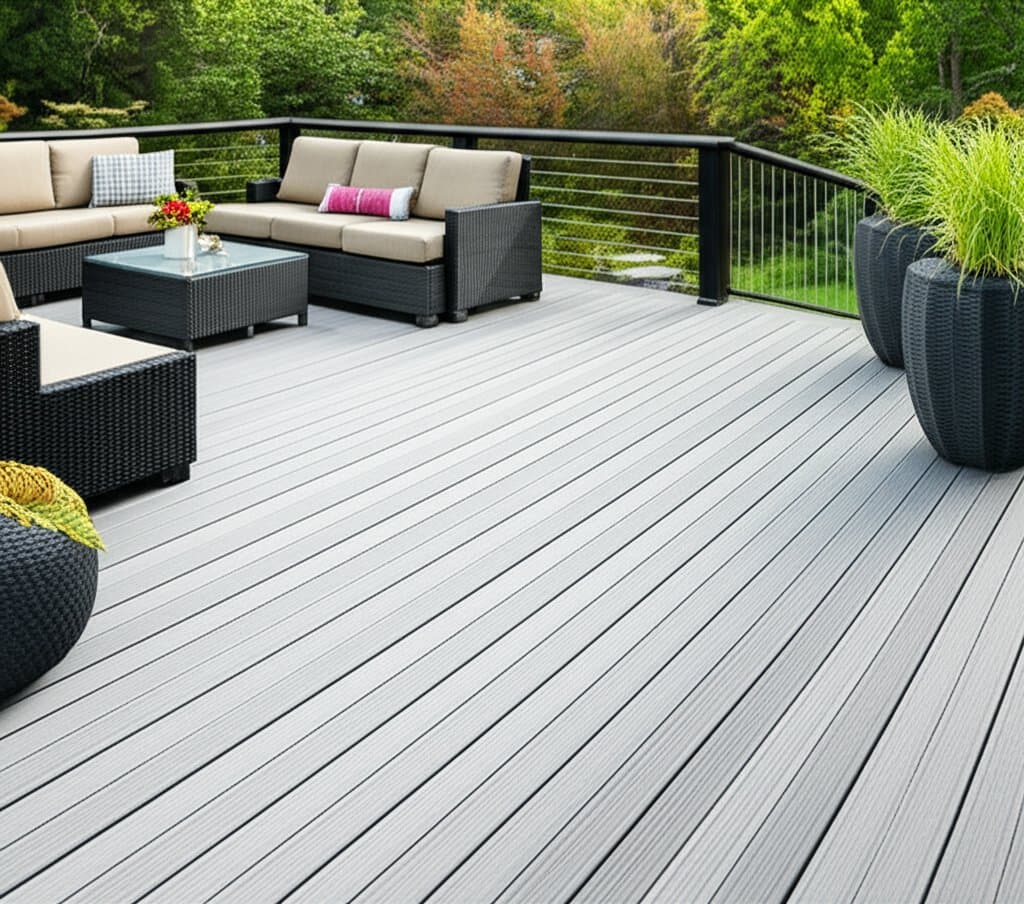Key Points
- Recycled plastic lumber provides enduring performance with minimal ongoing maintenance requirements.
- It generates a return on investment via reduced upkeep expenses and enhanced property value.
- The material withstands moisture, rot, and insect damage, suiting diverse climate conditions.
- Selecting recycled plastic decking advances circular economy principles and diminishes landfill contributions.
- Thorough installation and design considerations guarantee structural reliability and visual harmony.
The Challenge of Building a Deck That Lasts
Homeowners envision an outdoor deck that seamlessly extends their indoor living areas. Traditional wood decking, however, requires persistent care. Tasks such as sanding, staining, and sealing occur yearly, and despite efforts, boards often warp or deteriorate. Contemporary homeowners seek robust solutions that avoid environmental impact and eliminate relentless maintenance demands. This need positions recycled plastic lumber as a pivotal option in sustainable construction discussions.
Why Recycled Plastic Lumber Matters
Sustainable materials have evolved from optional selections to essential investments that safeguard finances and the environment. Recycled plastic lumber derives from post-consumer and post-industrial plastics, converting potential waste into superior building components. It repels moisture, resists fading, and deters pests, while avoiding the splintering and cracking common in natural wood.
On the financial side, it yields tangible benefits. Initial expenses range 10 to 25 percent above those of pressure-treated wood, yet savings emerge from decreased maintenance and fewer replacements. Across a deck's standard 25- to 30-year lifespan, owners typically recoup costs and achieve net gains through elevated property attractiveness.
Environmentally, each square foot of this lumber diverts plastics from landfills and marine ecosystems. Homeowners find profound fulfillment in linking personal enhancements to broader ecological stewardship.
Comparing Materials: Plastic, Wood, and Composites
Assessing recycled plastic lumber's role in the decking landscape highlights its strengths.
- Pressure-Treated Wood: Features low initial pricing but incurs high maintenance and limited durability. Frequent sealing and board replacements drive cumulative costs.
- Composite Decking: Blends wood fibers with plastics for moderate resilience, yet remains susceptible to mold and color loss.
- Recycled Plastic Lumber: Composed solely of recycled polymers, it excels in water resistance, extended service life, and consistent coloration.
Considering full lifecycle, plastic lumber endures approximately twice the duration of wood with nearly zero maintenance beyond routine cleaning. Such attributes position it favorably for residential and commercial applications alike.
Performance and Longevity
Premium recycled plastic decking preserves its form and hue for decades. It counters ultraviolet exposure, moisture uptake, and pest attacks. Free from the need for chemical preservatives, it eliminates hazardous residues in outdoor settings.
For households, this translates to safe, comfortable surfaces for bare feet and reduced injury risks. For property owners, it minimizes time and funds allocated to repairs. Studies indicate lifetime operational savings of up to 30 percent relative to conventional options.
To maximize longevity, select boards with reinforced cores for high-traffic zones and ensure proper ventilation beneath the deck to prevent heat buildup.
Design Flexibility and Aesthetic Options
Advancements have elevated recycled plastic lumber beyond basic functionality. Modern offerings include wood-grain textures and shades that replicate oak, cedar, or teak finishes. Available in earth tones, grays, and bold accents, these planks adapt to various home styles, from rustic cabins to sleek contemporaries.
Architects value the material's workability for intricate designs, such as curved benches or tiered platforms, unhindered by wood's tendency to bow under stress. Contractors employ familiar saws, drills, and screws, easing adoption while delivering innovative results.
Opt for concealed fasteners to achieve smooth, gap-free surfaces that enhance modern minimalism. Integrate with powder-coated aluminum railings or glass panels to craft sophisticated venues for gatherings, blending form with enduring function.
Cost, ROI, and Market Position
Per-square-foot pricing for recycled plastic lumber exceeds that of natural wood, yet lifecycle analysis reveals superior economics. A properly constructed deck endures over 50 years, compared to 20 to 25 for wood. Accounting for skipped staining, painting, and part swaps, overall expenses drop 15 to 25 percent lower than wood equivalents.
In resale markets, eco-materials command premiums. Data from real estate analyses reveal that green upgrades, including sustainable decks, yield 70 to 90 percent cost recovery via elevated listing prices and quicker transactions. This deck choice not only enriches everyday enjoyment but fortifies financial prospects.
Building for Climate and Code
Recycled plastic lumber demonstrates reliability in varied weather patterns. In humid tropics, it avoids expansion; in arid deserts, it resists brittleness from intense sunlight. This versatility streamlines project planning for builders across regions.
Many jurisdictions approve plastic lumber for structural and decorative uses. Confirm compliance with specifics on span ratings, guardrail specifications, and fire resistance. Engage certified installers versed in LEED standards to align projects with incentives that amplify value and marketability.
Maintenance and Care
Caring for recycled plastic decking proves simple and efficient. Sweep debris regularly and rinse with a hose or mild soap solution as needed. For persistent spots from barbecues or pollen, apply non-abrasive cleaners and soft brushes.
Moisture impermeability prevents mildew, and expansion joints maintain fastener integrity. Steer clear of harsh chemicals or high-pressure washers above 1,500 PSI to safeguard the protective cap layer. These practices sustain a pristine appearance with under an hour of effort annually.
Steps to Implement Your Recycled Plastic Deck
Embark on your project by evaluating usage: Will it host barbecues for 20 guests or serve as a quiet reading nook? Measure the area precisely and sketch layouts incorporating stairs, lighting, and furniture placement.
Consult reputable suppliers for samples to match your vision. Hire licensed professionals experienced in polymer installations to handle permits and ensure level foundations. Track progress with a timeline that includes weatherproofing and final inspections.
Adopting recycled plastic decking surpasses mere material selection. It embodies intentional choices for resilient, earth-friendly spaces that enrich life and legacy.









